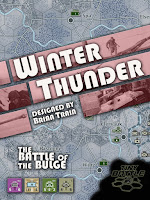We know you want it, buy it here!
The story of High Speed Hover Tank began last year when my wife, Mary, was running Tiny Battle. (She stepped down in February of this year.) She and Mark were trying to get the rights to a certain out-of-print sci-fi wargame about hover tanks, and the current rights-holder said no. So I said to Mary, "Well, I can probably do a game about high speed hover tanks for you guys if you want." She said sure, and then asked me what I would call it. I shrugged: "High Speed Hover Tank." She asked Mark about it, since he's the guy that signs the checks, and he said it sounded great. So, now all I had to do was design the darn thing.
Now, most of my designs are historically-based, and the process is initiated by my interest in the topic or period. Even those projects that were initiated largely because of someone else's interest were ultimately informed by my passion for history, and my ideas about how to best represent the period or situation. I probably wouldn't have done the upcoming Thor's Hammer if Mark hadn't asked me for a game on Viking land battles using my Shields & Swords system, but as a middle ages nut, it fit me like a glove. But with High Speed Hover Tank, I was really working in unfamiliar territory, and I didn't really have anything particular in mind other than the title. I spent a lot of time casting around, trying to figure out what the heck this thing was going to look like. The "Look", in the literal sense, turned out to the be the key.
I was still shrugging and futzing around in search of an actual, workable idea for the game beyond a title when Mary suggested the use of one-inch counters, using a new template that Tiny Battle's regular printer, SPOD, had created. Bigger counters meant I'd have room for multiple weapon factors per Tank, and for special icons to denote different types of weapons. This in turn suggested the use of different types of dice, and that's where the D6-D8-D10 combat system originated. Now, I have to say, I'm not a huge fan of D10s, and have never used them before, because they generally feel too "swingy" for me. But for this project, "swingy" was a plus, not a minus; wild swings of fortune seemed more appropriate for a fast-paced action combat game than for a sober-minded study of supply-logistics problems of nineteenth century warfare. I decided early on to emphasize, rather than mitigate, that swing factor, and that's when your own tank started blowing up when you rolled a zero. And it wasn't enough for it to blow up; it had to blow up spectacularly, and that's where the Kerplow! Deck came into play. And heck, if I'm going to have cards anyway, I might as well have some Action Cards. From there came the sequence of play-activate one tank, or use a card to activate multiples as well as the card draw mechanics, and each scenario's specific Empty Deck Effect. And all that, the heart and veins and guts of the whole thing, really came from the decision to use one-inch counters.
One-inch counters, combined with Tiny Battle's standard map size of 11x17 inches, also influenced the decision to go with a half-inch grid for movement. If I had gone with hexes and made them large enough to comfortably accommodate one-inchers, Iíd end up with a hex grid that was something like 14 hexes across and 9 down. This was problematic. It was important to me that the fastest Tanks have very high movement factors, and the toughest, heaviest Tanks have much lower Speeds in comparison. I wanted to have small, gradual differences in speed between Tanks of the same class. But I knew right away that I couldn't go as high as I would like with a map that spans fourteen hex columns, because the fast Tanks would go from one end to the other in the blink of an eye. Dialing down the unit speeds so that it would take at least two or three turns to get from one end to the other wouldn't allow for the subtle differences within each class, because the range of available numbers would be much less. Switching over to a one-inch grid would give me more spaces to work with, but still not enough. The half-inch grid, and the rather unique way the one-inch counters move across it, allowed for the grain I wanted, and for the speed without breaking the game. The fastest Tank moves 13 squares in a turn, and the slowest Tanks move 6. The fast Tanks are even faster than that, though, since they change facing for free and can move diagonally, something the HVY Tanks can't do.
So, in a way, all the game's mechanisms were inspired by, and progressed from, the decision to use one-inch square counters. While I always try to design to meet production restraints, it was the first time I can think of where the measurements of the pieces themselves dictated such the game's mechanisms to such a large degree. I didn't just design a game that happened to use one-inch counters; I designed a game that really could only use one-inch counters.





















